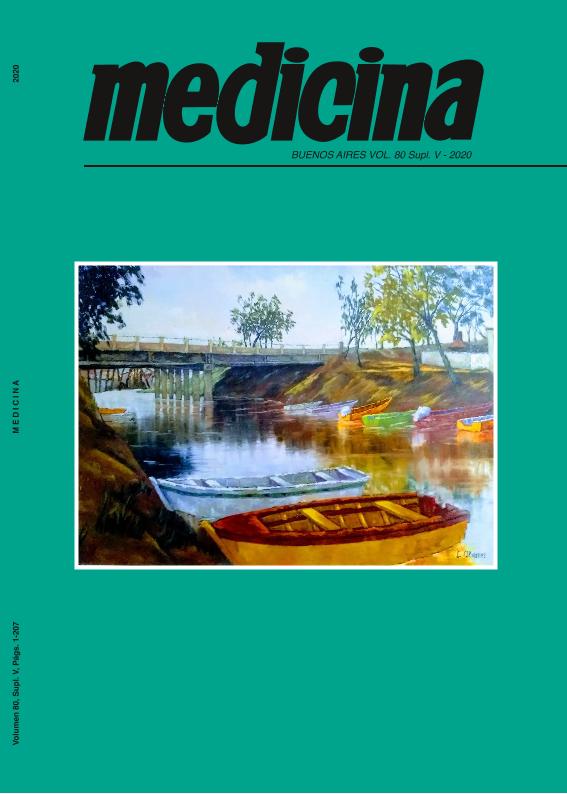Mostrar el registro sencillo del ítem
dc.contributor.author
Fernández Chávez, Lucía

dc.contributor.author
Peros, Iván
dc.contributor.author
Schweitzer, Karen

dc.contributor.author
Alonso, Exequiel Gonzalo

dc.contributor.author
Gandini, Norberto Ariel

dc.contributor.author
Facchinetti, Maria Marta

dc.contributor.author
Curino, Alejandro Carlos

dc.contributor.author
Colo, Georgina Pamela

dc.contributor.other
Kotsias, Basilio Aristides

dc.contributor.other
de Vito, Eduardo

dc.contributor.other
Narvaiz Kantor, Isabel
dc.contributor.other
Semeniuk, Guillermo Basilio

dc.date.available
2023-06-08T13:23:15Z
dc.date.issued
2020
dc.identifier.citation
Role of RHOA-activator in breast cancer progression; LXV Reunión Anual De La Sociedad Argentina De Investigación Clínica; LXIII Reunión Anual De La Sociedad Argentina De Inmunología y Reunión Anual De La Sociedad Argentina De Fisiología; Buenos Aires; Argentina; 2020; 120-120
dc.identifier.issn
0025-7680
dc.identifier.uri
http://hdl.handle.net/11336/199983
dc.description.abstract
Cells express different classes of fibronectin (FN)-binding integrins, which induce signalling pathways that integrate Rho-GTPases to convert integrin signals into specific effector functions. The aim of this work is to study the relationship between differential expression of integrins and specific activation of Rho-GTPases in cancer. Using genetically engineered cells, we observed that α5β1-integrins pro- moted the formation of small adhesions and low RhoA activation, while αVβ3-expressing cells showed large adhesions, thick stress fibers and high RhoA activation. To further analyse these cellular phenotypes, we looked for specific RhoA activators (GEFs). For this purpose, we performed Mass Spectrometry analysis follow by bio- chemical assays and observed that GEF-H1 activation is αVβ3-in- tegrin dependent. By bioinformatic analysis using a mRNA dataset (Oncomine) we found high GEF-H1 expression in human breast cancer compared with non-tumoral breast tissue. In addition, high GEF-H1 expression correlated with a lower patient survival (n= 65, p=0.0071). We also observed by immunohistochemistry a significant GEF-H1 over-ex- pression in human breast cancer biopsies compared with normal tissue (n=72, p=0.0201). Furthermore, GEF-H1 protein expression levels correlate with the invasive potential of human and murine breast cancer cell lines. Using CRISPR/Cas9 technology, we gen- erated GEF-H1-knock out (KO) clones in a murine invasive breast cancer cell. We observed a significant decrease in the migration and invasion rates in GEF-H1-KO cells (p<0.001) and a correlation with a decrease in focal adhesion formation and signal- ing. These results showed that GEF-H1-RhoA activation may mediate the signaling involved in controlling cell structure, proliferation, mi- gration and invasion of breast cancer cells. In addition, the studies in human tumor samples suggest that GEF-H1 might be a potential tumoral biomarker.
dc.format
application/pdf
dc.language.iso
eng
dc.publisher
Fundación Revista Medicina
dc.rights
info:eu-repo/semantics/openAccess
dc.rights.uri
https://creativecommons.org/licenses/by-nc-sa/2.5/ar/
dc.subject
RHOA
dc.subject
GEF-H1
dc.subject
BREAST CANCER
dc.subject.classification
Bioquímica y Biología Molecular

dc.subject.classification
Medicina Básica

dc.subject.classification
CIENCIAS MÉDICAS Y DE LA SALUD

dc.title
Role of RHOA-activator in breast cancer progression
dc.type
info:eu-repo/semantics/publishedVersion
dc.type
info:eu-repo/semantics/conferenceObject
dc.type
info:ar-repo/semantics/documento de conferencia
dc.date.updated
2023-06-01T10:11:18Z
dc.identifier.eissn
1669-9106
dc.journal.volume
80
dc.journal.number
Suplemento V
dc.journal.pagination
120-120
dc.journal.pais
Argentina

dc.journal.ciudad
Buenos Aires
dc.description.fil
Fil: Fernández Chávez, Lucía. Consejo Nacional de Investigaciones Científicas y Técnicas. Centro Científico Tecnológico Conicet - Bahía Blanca. Instituto de Investigaciones Bioquímicas de Bahía Blanca. Universidad Nacional del Sur. Instituto de Investigaciones Bioquímicas de Bahía Blanca; Argentina
dc.description.fil
Fil: Peros, Iván. Consejo Nacional de Investigaciones Científicas y Técnicas. Centro Científico Tecnológico Conicet - Bahía Blanca. Instituto de Investigaciones Bioquímicas de Bahía Blanca. Universidad Nacional del Sur. Instituto de Investigaciones Bioquímicas de Bahía Blanca; Argentina
dc.description.fil
Fil: Schweitzer, Karen. Consejo Nacional de Investigaciones Científicas y Técnicas. Centro Científico Tecnológico Conicet - Bahía Blanca. Instituto de Investigaciones Bioquímicas de Bahía Blanca. Universidad Nacional del Sur. Instituto de Investigaciones Bioquímicas de Bahía Blanca; Argentina
dc.description.fil
Fil: Alonso, Exequiel Gonzalo. Consejo Nacional de Investigaciones Científicas y Técnicas. Centro Científico Tecnológico Conicet - Bahía Blanca. Instituto de Investigaciones Bioquímicas de Bahía Blanca. Universidad Nacional del Sur. Instituto de Investigaciones Bioquímicas de Bahía Blanca; Argentina
dc.description.fil
Fil: Gandini, Norberto Ariel. Consejo Nacional de Investigaciones Científicas y Técnicas. Centro Científico Tecnológico Conicet - Bahía Blanca. Instituto de Investigaciones Bioquímicas de Bahía Blanca. Universidad Nacional del Sur. Instituto de Investigaciones Bioquímicas de Bahía Blanca; Argentina
dc.description.fil
Fil: Facchinetti, Maria Marta. Consejo Nacional de Investigaciones Científicas y Técnicas. Centro Científico Tecnológico Conicet - Bahía Blanca. Instituto de Investigaciones Bioquímicas de Bahía Blanca. Universidad Nacional del Sur. Instituto de Investigaciones Bioquímicas de Bahía Blanca; Argentina
dc.description.fil
Fil: Curino, Alejandro Carlos. Consejo Nacional de Investigaciones Científicas y Técnicas. Centro Científico Tecnológico Conicet - Bahía Blanca. Instituto de Investigaciones Bioquímicas de Bahía Blanca. Universidad Nacional del Sur. Instituto de Investigaciones Bioquímicas de Bahía Blanca; Argentina
dc.description.fil
Fil: Colo, Georgina Pamela. Consejo Nacional de Investigaciones Científicas y Técnicas. Centro Científico Tecnológico Conicet - Bahía Blanca. Instituto de Investigaciones Bioquímicas de Bahía Blanca. Universidad Nacional del Sur. Instituto de Investigaciones Bioquímicas de Bahía Blanca; Argentina
dc.relation.alternativeid
info:eu-repo/semantics/altIdentifier/url/https://www.saic.org.ar/revista-medicina
dc.conicet.rol
Autor

dc.conicet.rol
Autor

dc.conicet.rol
Autor

dc.conicet.rol
Autor

dc.conicet.rol
Autor

dc.conicet.rol
Autor

dc.conicet.rol
Autor

dc.conicet.rol
Autor

dc.coverage
Nacional
dc.type.subtype
Reunión
dc.description.nombreEvento
LXV Reunión Anual De La Sociedad Argentina De Investigación Clínica; LXIII Reunión Anual De La Sociedad Argentina De Inmunología y Reunión Anual De La Sociedad Argentina De Fisiología
dc.date.evento
2020-11-10
dc.description.ciudadEvento
Buenos Aires
dc.description.paisEvento
Argentina

dc.type.publicacion
Journal
dc.description.institucionOrganizadora
Sociedad Argentina de Investigación Clínica
dc.description.institucionOrganizadora
Sociedad Argentina de Inmunología
dc.description.institucionOrganizadora
Sociedad Argentina de Fisiología
dc.source.revista
Medicina (Buenos Aires)

dc.date.eventoHasta
2020-11-13
dc.type
Reunión
Archivos asociados
